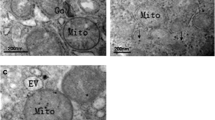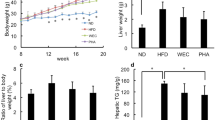Abstract
The effects ofl-ascorbyl stearate andl-ascorbyl palmitate on carbon tetrachloride-induced alterations in glutathione and ascorbic acid content in mouse livers were investigated. Powdered food containing 1% ascorbate ester was given to mice for 3 days before and 1 day after a single injection of CCl4 (0.1 ml/kg, i.p.). Biochemical parameters were determined 1 day after the CCl4 administration. The ascorbate esters markedly attenuated CCl4induced alterations such as reductions in ascorbate content and hepatic glutathioneS-transferase (GST) activity, and increases in glutathione and calcium content and serum GST activity. The CCl4-induced rise in thiobarbituric acid-reactive substances, an index of lipid peroxidation, was not affected by ascorbate feeding. These findings suggest that exogenous ascorbate, in addition to endogenous glutathione, is available to maintain the intracellular milieu in a reduced state, and that this system operates more effectively in aqueous compartments than in membrane lipid bilayers.
Similar content being viewed by others
References
Adams Jr JD, Lauterburg BH, Mitchell JR (1983) Plasma glutathione and glutathione disulfide in the rat: regulation and response to oxidative stress. J Pharmacol Exp Ther 227: 749–754
Agarwal AK, Mehendale HM (1984) CCl4-induced alterations in Ca++ homeostasis in chlordecone and phenobarbital pretreated animals. Life Sci 34: 141–148
Albano E, Bellomo G, Parola M, Carini R, Dianzani MU (1991) Stimulation of lipid peroxidation increases the intracellular calcium content of isolated hepatocytes. Biochim Biophys Acta 1091: 310–316
Asaoka K, Takahashi K (1983) A colorimetric assay of glutathione 5-transferases using o-dinitrobenzene as a substrate. J Biochem 94: 1985–1988
Burkitt MJ, Gilbert BC (1990) Model studies of the iron-catalysed Haber-Weiss cycle and the ascorbate-driven Fenton reaction. Free Radic Res Commun 10: 265–280
Butler TC (1961) Reduction of carbon tetrachloride in vivo and reduction of carbon tetrachloride and chloroform in vitro by tissues and tissue constituents. J Pharmacol Exp Ther 134: 311–319
Connerty HV, Briggs AR (1966) Determination of serum calcium by means of orthocresolphthalein complexone. Am J Pathol 45: 290–296
Connor HD, Lacagnin LB, Knecht KT, Thurman RG, Mason RP (1990) Reaction of glutathione with a free radical metabolite of carbon tetrachloride. Mol Pharmacol 37: 443–451
Dolphine D, Avramovic O, Poulson R (eds) (1989) Glutathione: chemical, biochemical, and medical aspects. Wiley, New York
Farber JL (1990) The role of calcium in lethal cell injury. Chem Res Toxicol 3: 503–508
Gotoh N, Niki E (1992) Rates of interaction of superoxide with vitamin E, vitamin C and related compounds as measured by chemiluminescence. Biochim Biophys Acta 1115: 201–207
Hargreaves RJ, Evans JG, Pelling D, Butterworth KR (1982) Studies on the effects ofl-ascorbic acid on acetaminophen-induced hepatotoxicity: II. an in vivo assessment in mice of the protection afforded by various dosage forms of ascorbate. Toxicol Appl Pharmacol 64: 380–392
Jain A, Martensson J, Mehta T, Krauss AN, Auld PAM, Meister A (1992) Ascorbic acid prevents oxidative stress in glutathione-dependent mice: effects on lung type 2 cell lamellar bodies, lung surfactant, and skeletal muscle. Proc Natl Acad Sci USA 89: 5093–5097
Jonker D, Lee VS, Hargreaves RJ, Lake BG (1988) Comparison of the effects of ascorbyl palmitate andl-ascorbic acid on paracetamol-induced hepatotoxicity in the mouse. Toxicology 52: 287–295
Kostyuk VA, Potapovich AI (1991) Damage of rat liver microsomal mixed function oxidase system by carbon tetrachloride; in vivo study with selective inhibitor of lipid peroxidation. Biochem Int 25: 349–353
Lowrey K, Glende Jr EA, Recknagel RO (1981) Destruction of liver microsomal calcium pump activity by carbon tetrachloride and bromotrichloromethane. Biochem Pharmacol 30: 135–140
Maellaro E, Casini AF, Bello BD, Comporti M (1990) Lipid peroxidation and antioxidant systems in the liver injury produced by glutathione depleting agents. Biochem Pharmacol 39: 1513–1521
Martensson J, Meister A (1991) Glutathione deficiency decreased tissue ascorbate levels in newborn rats: ascorbate spares glutathione and protects. Proc Natl Acad Sci USA 88: 4656–4660
McCay PD, Lai EK, Poyer JL, DuBose CM, Janzen ED (1984) Oxygen- and carbon-centered free radical formation during carbon tetrachloride metabolism: observation of lipid radicals in vivo and in vitro. J Biol Chem 259: 2135–2143
Meister A, Anderson ME (1983) Glutathione. Annu Rev Biochem 52: 711–760
Miller DM, Aust SD (1989) Studies of ascorbate-dependent, iron-catalysed lipid peroxidation. Arch Biochem Biophys 271: 113–119
Mitra A, Ravikumar VC, Bourn WM, Bourcier DR (1988) Influence of ascorbic acid esters on acetaminophen-induced hepatotoxicity in mice. Toxicol Lett 44: 39–46
Mitra A, Kulkarni AP, Ravikumar VC, Bouicier DR (1991) Effect of ascorbic acid esters on hepatic glutathione levels in mice treated with a hepatotoxic dose of acetaminophen. J Biochem Toxicol 6: 93–100
Moore L, Davenport GR, Landon EJ (1976) Calcium uptake of a rat liver microsomal subcellular fraction in response to in vivo administration of carbon tetrachloride. J Biol Chem 251: 1197–1201
Nakagawa K (1991) Decreased glutathioneS-transferase activity in mice livers by acute treatment with lead, independent of alteration in glutathione content. Toxicol Lett 56: 13–17
Nicotera P, Bellomo G, Orrenius S (1990) The role of Ca2= in cell killing. Chem Res Toxicol 3: 484–494
Padh H (1990) Cellular function of ascorbic acid. Biochem Cell Biol 68: 1166–1173
Poyer JL, Floyd RA, McCay PB, Janzen EG, Davis ER (1978) Spin-trapping of the trichloromethyl radical produced during enzymic NADPH oxidation in the presence of carbon tetrachloride or bromotichloromethane. Biochim Biophys Acta 539: 402–409
Rao DNR, Fischer V, Mason RP (1990) Glutathione and ascorbate reduction of the acetaminophen radical formed by peroxidase: detection of the glutathione disulfide radical anion and the ascorbyl radical. J Biol Chem 265: 844–847
Reed DJ (1990) Review of the current status of calcium and thiols in cellular injury. Chem Res Toxicol 3: 495–502
Schanne FAX, Kane AB, Young EE, Farber JL (1979) Calcium dependence of toxic cell death: a final common pathway. Science 206: 700–702
Tsao CS, Leung PY (1989) Effect of ascorbic acid intake on tissue dehydroascorbic acid in mice. Nutr Res 9: 1371–1379
Tsao CS, Young M (1989) Effect of exogenous ascorbic acid intake on biosynthesis of ascorbic acid in mice. Life Sci 45: 1553–1557
Tsao CS, Leung PY, Young M (1987) Effect of dietary ascorbic acid intake on tissue vitamin C in mice. J Nutr 117: 291–297
Tsokos-Kuhn JO (1989) Evidence in vivo for elevation of intracellular Ca2+ in the liver after diquat, acetaminophen and CCl4. Biochem Pharmacol 38: 3061–3065
Tsokos-Kuhn JO, Todd EL, McMillin-Wood JB, Mitchell JR (1985) ATP-dependent calcium uptake by rat liver plasma membrane vesicles: effects of alkylating hepatotoxins in vivo. Mol Pharmacol 28: 56–61
Tsujimura M, Uchiyama Y, Fujita A (1971) On a fractional determination of ascorbic, dehydroascorbic, and diketogulonic acids. Vitamins (Japan) 43: 210–220
Wills ED (1966) Mechanisms of lipid peroxide formation in animal tissues. Biochem J 99: 667–676
Winkler BS (1987) In vitro oxidation of ascorbic acid and its prevention by GSH. Biochim Biophys Acta 925: 258–264
Winkler BS (1992) Unequivocal evidence in support of the non-enzymatic redox coupling between glutathione/glutathione disulfide and ascorbic acid/dehydroascorbic acid. Biochim Biophys Acta 1117: 287–290
Yamamoto H (1990) Relation of Ca++ accumulation and lipid peroxidation with CCl4-induced toxicity in the rat liver. Pharmacol Toxicol 66: 213–216
Author information
Authors and Affiliations
Rights and permissions
About this article
Cite this article
Nakagawa, K. Carbon tetrachloride-induced alterations in hepatic glutathione and ascorbic acid contents in mice fed a diet containing ascorbate esters. Arch Toxicol 67, 686–690 (1993). https://doi.org/10.1007/BF01973692
Received:
Accepted:
Issue Date:
DOI: https://doi.org/10.1007/BF01973692




